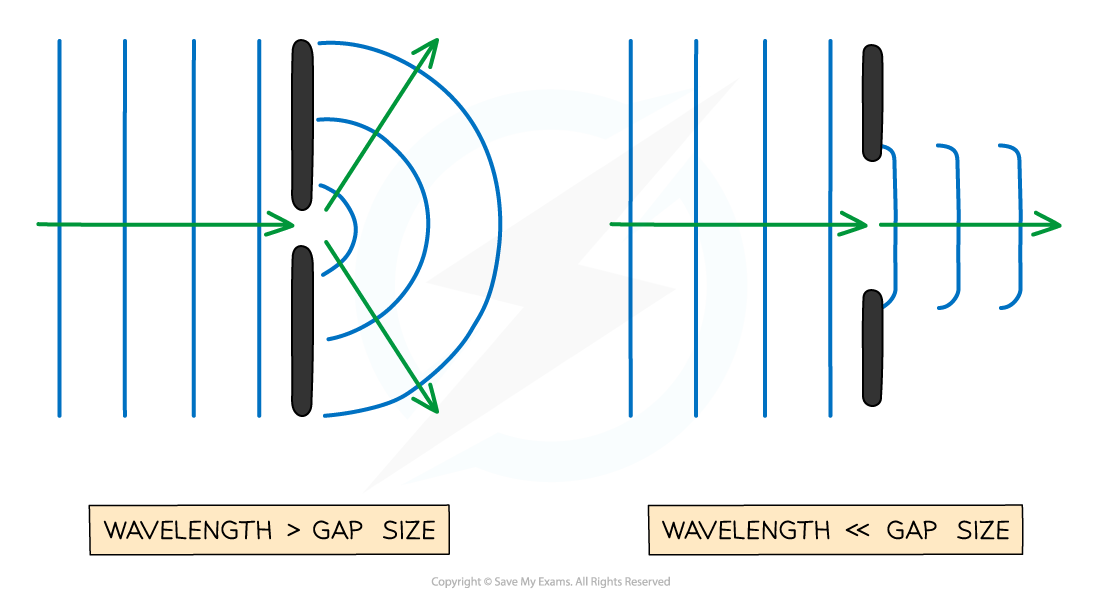Chapters
In this article, we will uncover the secrets behind wave diffraction. We will explore how waves bend and spread out when encountering obstacles or passing through openings. Additionally, we will learn about the factors that influence diffraction, such as gap width, wavelength, wavefront shape, obstacle size, and distance. Moreover, we will discover the practical applications of diffraction in sound engineering, photography, communication, and X-ray analysis. By delving into these fascinating applications, we will appreciate how diffraction enhances our understanding of waves and contributes to advancements in various scientific disciplines.

Diffraction of Waves
We can define diffraction as:
Diffraction of waves refers to the phenomenon where waves spread out and change direction as they pass through a gap or around an obstacle.
When waves encounter an opening or the edge of a barrier, they don't simply stop or continue in a straight line. Instead, they bend or "diffract" around the edges, spreading out of the wave pattern.
This is spreading out because different parts of the wavefront experience different amounts of obstruction or interference as they pass through the gap or around the obstacle. As a result, the waves "bend" and create a new wave pattern beyond the hole or barrier.
The extent of diffraction depends on the size of the gap or obstacle relative to the wavelength of the waves. Significant diffraction occurs if the opening or barrier is similar in size to the wavelength, causing a noticeable spreading of the waves. However, the diffraction effect becomes less pronounced if the crack is much larger or smaller than the wavelength.
Diffraction is an essential concept in physics as it helps explain various phenomena, such as the spreading of sound waves around corners, the behaviour of light around obstacles, and the interference patterns observed in experiments involving waves.
Factors Affecting Diffraction of Waves
Several factors influence the extent and characteristics of diffraction. Let's explore the key elements:
- Gap Width: The width of the gap or the size of the obstacle plays a crucial role in diffraction. Significant diffraction occurs if the gap is narrower compared to the wavelength of the waves, such as light or sound waves. A narrower gap allows waves to spread more, resulting in a more noticeable diffraction pattern.

- Wavelength: The wavelength of the waves is another critical factor. Longer wavelengths, like those of sound waves, diffract more than shorter wavelengths, like those of light waves. Sound waves are more likely to exhibit noticeable diffraction effects in everyday situations.

- Wavefront Shape: The shape of the wavefront, which represents the crests or troughs of a wave, also affects diffraction. When the wavefront is a plane (flat), it diffracts differently than when it is curved. A curved wavefront, such as that produced by a spherical wave source, tends to diffract more around obstacles or through gaps.
- Obstacle Size: The size of the obstacle about the wavelength of the waves also influences diffraction. A minor block or opening allows waves to spread out more, resulting in a more pronounced diffraction effect. On the other hand, a larger barrier might cause less diffraction or even block the waves entirely.
- Distance: The distance between the source of the waves and the diffracting object also affects diffraction. As the distance increases, the spreading out of waves becomes more noticeable. Therefore, diffraction tends to be more prominent when the observer or the diffracting object is farther away from the source.
Understanding these factors helps explain the behaviour of waves when they encounter gaps or obstacles. By considering the gap width, wavelength, wavefront shape, obstacle size, and distance, we can predict and analyze the diffraction patterns observed in various situations, from bending light around corners to spreading sound waves through doorways.
Applications of Diffraction in Different Fields
Diffraction, the bending or spreading out of waves, has practical applications in several fields. Some of them are explained below:
- Sound Engineering: Diffraction is vital in designing sound systems and optimizing building acoustics. By understanding how sound waves diffract around obstacles, such as walls or furniture, engineers can plan the placement of speakers and minimize tough blockages, ensuring better audio distribution and quality.
- Radio Waves and Communication: Diffraction enables radio waves to propagate around obstacles, making it possible to receive signals even when the transmitting antenna is not in the direct line of sight. This diffraction property allows radio communication around buildings, mountains, and other barriers, ensuring reliable wireless communication.
- Camera and Photography: The diffraction phenomenon is essential in determining the resolution and sharpness of photographs. When light passes through the aperture of a camera lens, it diffracts, affecting the overall clarity of the image. Photographers must consider balancing the aperture size and diffraction to achieve optimal image quality.
- Holography: Diffraction also finds application in holography, the technology used to create three-dimensional images. In holography, a laser beam is split into two, with one part illuminating the object and the other as a reference beam. When these beams meet, they interfere and create an intricate pattern of light and dark regions. This interference pattern is recorded on a photosensitive material, forming a hologram. When illuminated with coherent light, such as another laser beam, the hologram diffracts the light, reconstructing the original object in three dimensions.
- X-ray Diffraction: X-ray diffraction is a technique used to study the arrangement of atoms in crystalline materials. The waves diffract by directing X-rays at a crystal, creating a distinct pattern. Analyzing this pattern helps scientists determine the material's atomic structure, aiding in fields such as material science, chemistry, and biology.
- Optical Gratings: Optical gratings consist of closely spaced parallel slits or lines. When light passes through these gratings, it diffracts and creates interference patterns. These patterns are used in spectrometers to analyze the composition of light sources and identify specific wavelengths or colours.













You are the best,, coz you have gotten content about the topics
Hello ! Glad to hear that you’ve found the content useful!